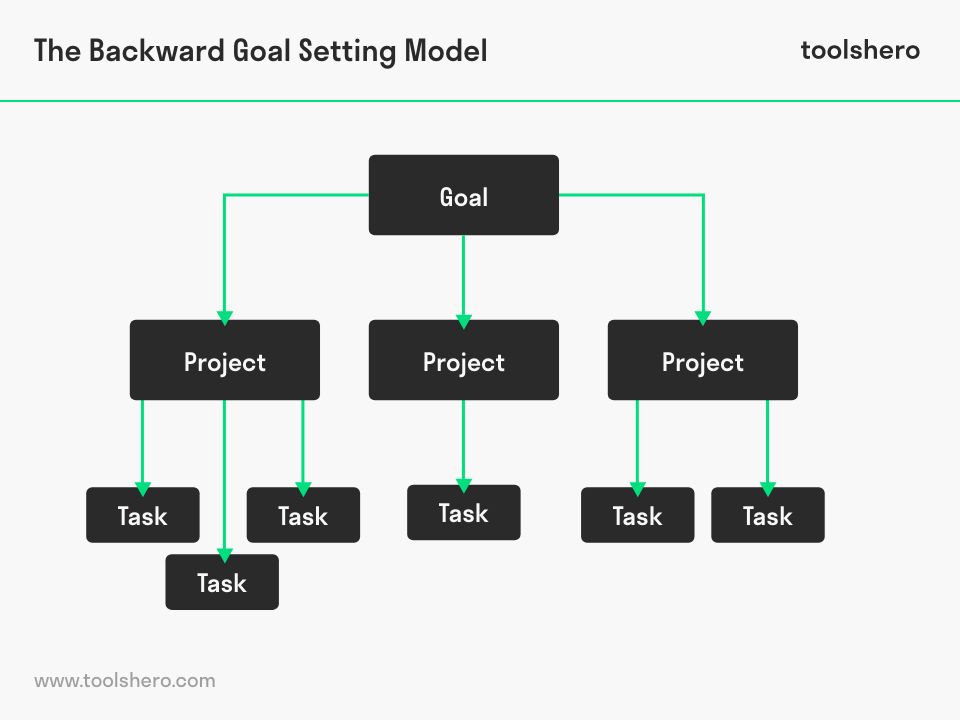Backward Goal Setting

Backward Goal Setting: this article explains Backward Goal Setting in a practical way. This article contains the general definition of the Back Goal Setting method, an example of the process and practical tips. After reading it you will understand the basics of this personal development tool. Enjoy reading!
What is Backward Goal Setting?
Setting personal and professional goals by, for example, using the SMART Goals method, is often a time-consuming and overwhelming process.
Although very important, for this reason it is one of the most postponed activities of entrepreneurs and professionals. That is because time has to be made available for it, which is a scarce commodity. It also involves thinking, planning and developing a vision for the future. It’s no wonder, then, that many people procrastinate on goal setting.
Nevertheless, setting the right goals does not have to be a time-consuming and intensive activity. Backward Goal Setting is a method that helps with this. With this method, you set a general end goal, and work backwards in steps that bring you closer and closer to the end goal. This article explains how it works.

Figure 1 – The Backward Goal Setting Model
Step 1: Set an end goal
Often it is not difficult to come up with an end goal. You probably already have several in mind. Those goals are probably not completely realistic, or maybe not possible at all.
Dozens, perhaps hundreds of ideas are reviewed, but often what remains is a quick thought. You may want to start a business, build a house, or write an autobiography.
For this method it is important that you choose 1 goal, and stick to it. It is a long-term goal, which means that the realization of that goal can take one or several years. The method also works for shorter-term goals, provided the goal can be accelerated.
Choose the goal that stands out from the other goals, such as a BHAG (Big Hairy Audacious Goals) described by Jim Collins. For the sake of the example, we are now starting our own company.
Step 2: Break the goal into smaller goals
The second step of the Backward Goal Setting process involves thinking about what needs to be done before the goal is reached. Think about where you want to be, what you need to do, and what smaller, supportive goals you need to achieve that will take you to the ultimate goal.
Smaller goals that need to be achieved before you can start your own business are, for example:
- Write a business plan and develop a Business Model Canvas
- Work on the value proposition (value proposition canvas)
- Calculate the financial consequences
- Choose a location
- Make a marketing plan
Each of the above supporting goals must be performed to achieve the main goal. The goals are part of the bigger picture, namely starting your business, but should be seen as independent goals.
Step 3: Break the Smaller Goals into Smaller Components
The third step of the Backward Goal Setting process involves breaking down the goals that were defined in the previous step. Writing a business plan is a goal that can seem overwhelming:
- Where do I start?
- What exactly is a business plan?
- Which elements in a business plan are important to my type of business?
Split the goal into, for example, the following elements:
- Determining the type of business plan
- Conducting customer segmentation
- Determining the distinctive character of your company
- Collecting financial data
- Developing planning and timeline
The above components of a business plan can also be further developed into smaller steps. Do this until you feel you can work with workable lists.
Step 4: Structure Your List with JTBD (Jobs To Be Done)
The final part of the Backward Goal Setting process is to create a list of individual actions that will take you step-by-step towards the end goal. It is important that you take dependency into account. This means that you take into account that some steps cannot be performed until a previous step has been completed.
For example, you cannot register the company with the Chamber of Commerce if you have not yet thought about a name.
A tip: keep each action item as simple as possible. You eventually want to have a list in front of you of actions that you can easily perform, one by one.
Making a list like this is essential because you build momentum this way. This prevents you from having to deal with setbacks because you have to wait a long time for the completion of a previous step.
Throughout the process, remember that every step is a step in the right direction. Before you know it, you’ll be halfway through the to-do list.
Benefits of Backward Goal Setting
The benefits of working and planning in the manner described above are visible between the lines. The main advantages are briefly explained below.
Clarity
This method provides clarity and prevents stagnation. Posing an end goal gives you a clear picture of where you want to be in the future. The smaller and clear steps in between ensure that you are not overwhelmed by the amount of work. Everything is worked out step by step.
Urgency
It’s normal for people to put off the biggest goals because getting started reminds us of the incredible amount of work ahead. Planning backwards helps create the urgency to take that first step.
Alternatives
Setting goals in reverse gives us a more complete picture of exactly what it takes to achieve success.
Driven by this vision of success, we will be more committed to achieving the goal. Thus, one will explore many ways to reach the goal. The more alternatives we come up with, the greater the chance that we will achieve the goal.
Concrete planning
Planning backwards reduces the chance that goals are formulated vaguely. This method emphasizes the importance of concrete actions and ensures that the planning is more accurate. Planning ahead is more likely to have intermediate goals and activities defined in a vague way.
Motivation
This method keeps us motivated. The entire process has already been mapped out and the end goal is waiting like a chest of gold on the horizon. The sense of progress, by completing the concrete action list, has a positive effect on the human reward system. This makes us increasingly motivated.
Now It’s Your Turn
What do you think? Do you recognize the explanation about Backward Goal Setting? Do you have experience setting ambitious goals? Do you ever get overwhelmed by the amount of things you have to do until you get to the end goal? What other methods and techniques for achieving goals can you share with us? Do you have any tips or additional comments?
Share your experience and knowledge in the comments box below.
More information
- Park, J., Lu, F. C., & Hedgcock, W. M. (2017). Relative effects of forward and backward planning on goal pursuit. Psychological science, 28(11), 1620-1630.
- Locke, E. A., & Latham, G. P. (1984). Goal setting: A motivational technique that works!.
- Wiese, J., Buehler, R., & Griffin, D. (2016). Backward planning: Effects of planning direction on predictions of task completion time. Judgment & Decision Making, 11(2).
- Lawlor, K. B. (2012). Smart goals: How the application of smart goals can contribute to achievement of student learning outcomes. In Developments in business simulation and experiential learning: Proceedings of the annual ABSEL conference (Vol. 39).
How to cite this article:
Janse, B. (2022). Backward Goal Setting. Retrieved [insert date] from Toolshero: https://www.toolshero.com/personal-development/backward-goal-setting/
Published on: 09/04/2022 | Last update: 08/15/2023
Add a link to this page on your website:
<a href=”https://www.toolshero.com/personal-development/backward-goal-setting/”>Toolshero: Backward Goal Setting</a>












